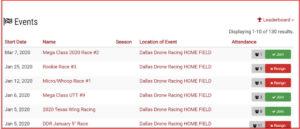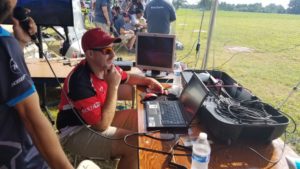Any new drone pilot is welcome to come race and meet other drone pilots
We understand that a new drone pilot can be overwhelmed and hesitant to jump into a race with other seasoned pilots. Because of this we have provided the below information to make a new pilot feel more prepared when they are ready to attend your first race
This information provides guidance as well as race day etiquette
Sign Up For The Race
Dallas Drone Racing is a tier 1 racing chapter and most all races are going to be MultiGP sanctioned races. This means that most all races will be listed  prior to race day allowing racers to sign up for a specific race. You can find the race requirements for you to successfully sign up on our race with us page.
prior to race day allowing racers to sign up for a specific race. You can find the race requirements for you to successfully sign up on our race with us page.
Inspect Your Gear
Your gear should be inspected to ensure it is ready for the race. This includes basic function of the drone and more importantly your video transmitter. When signing up for a race you will immediately be assigned a frequency and polarization. You should pre-configure your video transmitter to your assigned frequency and configure the transmit power to 25mW. Polarization pertains to the circular rotation your drone video antenna should be transmitting. You will be either assigned right or left hand polarization which requires a physical antenna change. It is best practice to bring right hand and left hand antennas for both your drone and FPV receiver to the race in case you are re-assigned a channel.
 One additional item that needs to be checked is your failsafe. The failsafe provides protection from the drone flying away in the event it looses communication with your RC controller. This needs to be configured on your drone which is tested during tech check therefore it needs to be working correctly before you arrive. Here is an educational video here and here discussing failsafe and how to configure it.
One additional item that needs to be checked is your failsafe. The failsafe provides protection from the drone flying away in the event it looses communication with your RC controller. This needs to be configured on your drone which is tested during tech check therefore it needs to be working correctly before you arrive. Here is an educational video here and here discussing failsafe and how to configure it.
Be On Time
Most races have a tech check before the race starts to check to ensure your drone is transmitting on the correct channel and at only 25mW. It is required that your drone video signal be checked as well as your failsafe. It is important that when you approach the tech check table that YOUR PROPS are off. Your video and signal strength should also be set to your assigned frequency. Being a new drone pilot or new to racing with us may cause you to require more time to get prepared so being on time helps ensure you can get ready for the race.

Consequently when you arrive late many race officials are busy producing a race. As a result they will put your tech check on the bottom of their priority list. This not only causes additional burden on the race officials but also can potentially cause you to miss heats waiting for your drone to be approved.
During The Race
It is very important to understand that anytime your drone is powered up it transmits a video signal. This can interfere with other pilots that might be in the air or in a race. Because of this your drone should only be powered up when it is your time to fly. Even if your drone has “pit mode” it is not recommended to rely on it to not cause interference. Even if you walk away from the pits and power up it still can interfere with others. Therefore it is best to ask race officials when it is appropriate to power up if you are needing to test or make changes to your drone.
Additionally, you want to be aware of the race heat that you are assigned to and be ready to walk to the starting blocks when it is your time. Delaying other pilots not only causes irritation but also causes them to loose battery power sitting on the blocks. Many times races are on tight schedules and avoidable delays does not set well with officials and other pilots.
After Flight
Its important to check your drone after each flight. Check that any screws are loose and that the frame is still in good shape. This also includes feeling the temperature of all motors and ESC (if possible) soon after landing. Hot motor/s mean either it is failing, a propeller is damaged or your tune might be way off. Warm motors are not uncommon depending on your flying style. Warm motors means you should be able keep your finger on it for a few seconds without burning yourself. If you experience hot motors feel free to ask other pilots and they can help diagnose the problem you might be having.
